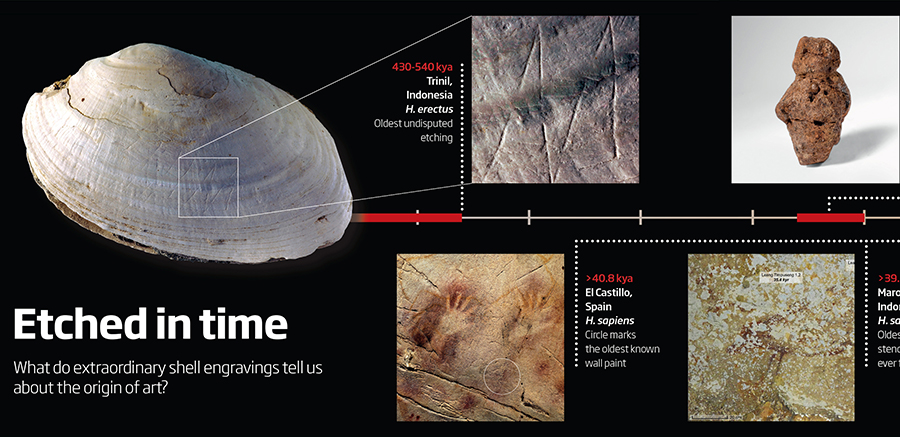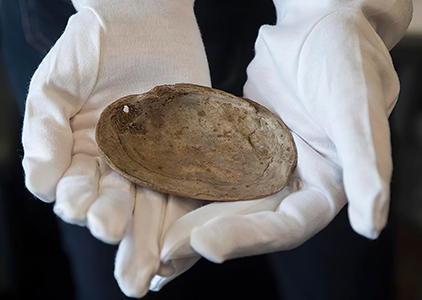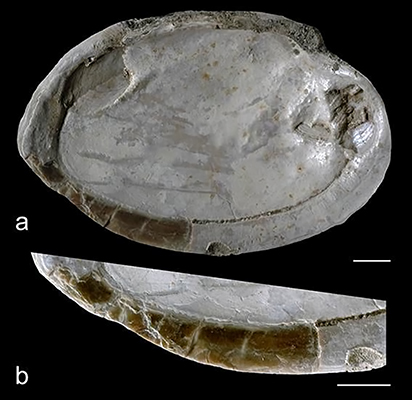Homo erectus, Java Man, Engraving on a shell
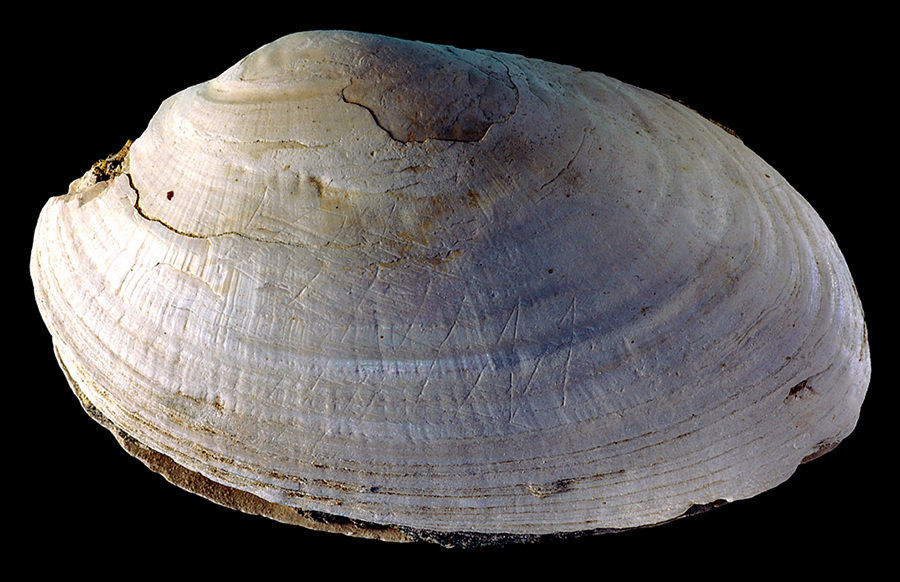
Deliberate scratching on a fossil Pseudodon, almost certainly an engraving made by Homo erectus at Trinil in Indonesia.
At around 500 000 BP, the shells represent the earliest evidence of such decorative marks.
Photo: Wim Lustenhouwer, VU University Amsterdam
Source: https://www.smithsonianmag.com/science-nature/oldest-engraving-shell-tools-zigzags-art-java-indonesia-humans-180953522/
Text below adapted from https://www.smithsonianmag.com/science-nature/oldest-engraving-shell-tools-zigzags-art-java-indonesia-humans-180953522/
On the banks of the Bengawan Solo River in Java, Indonesia, 19th-century physician Eugène Dubois uncovered an astounding fossil find: the bones of what appeared to be an ancient human, surrounded by animal remains and shells. Excavated in the 1890s, the site gained fame as the home of 'Java Man', better known today as Homo erectus.
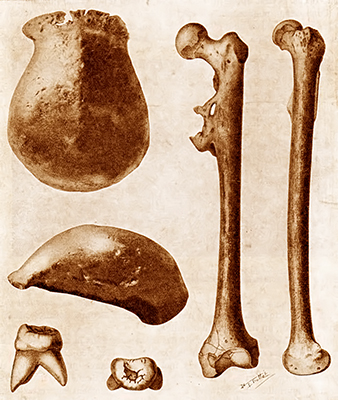
Original fossils of Pithecanthropus erectus (now Homo erectus) found in Java in 1891
Photo: scan by 'personal scan 120'
Permission: Public Domain
Dated to between a million and 700 000 years old, the bones immediately provoked controversy, because Dubois claimed they showed evidence of a transitional species between apes and humans. It turns out he was right - Homo erectus fossils have since been found in Africa and elsewhere in Asia, and it is possible the species is a direct ancestor of our own. But it's the palm-sized shells found alongside the Java remains that are raising big questions today. An examination of the shells published in Nature, Joordens et al. (2015), suggests that Homo erectus may have used the shells for tools and decorated some of them with geometric engravings. At around half a million years old, the shells represent the earliest evidence of such decorative marks and also the first known use of shells to make tools.
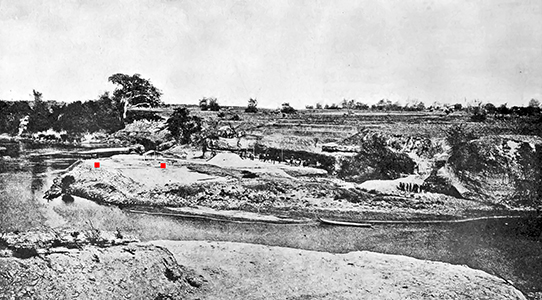
The Locality of the Pithecanthropus erectus / Homo erectus find, on the Bengawan Solo river, Near Trinal, Java.
The two red squares show where the femur (on the left) and the skullcap (on the right and further behind) were discovered.
Photo: Hrdlička (1916)
Permission: Public Domain

Original fossils of Pithecanthropus erectus (now Homo erectus) found in Java in 1891. It was on display at the exhibition 'Dubois' in the National Museum of Natural History 'Naturalis' in Leiden, the Netherlands.
Dutch anatomist Eugene Dubois had been fascinated with Charles Darwin's theories of evolution, so set out to find an early human.(1890s) He first described the species as Pithecanthropus erectus ('upright ape-man'), based on a calotte (skullcap) and a modern-looking femur found from the bank of the Bengawan Solo River at Trinil, in central Java. (This species is now regarded as Homo erectus.) His find is commonly referred to as Java Man.
Photo: Peter Maas
Permission: Creative Commons Attribution-Share Alike 3.0
Dubois collected 11 species of freshwater shells at the site, called Trinil. Most of them belong to the sub-species Pseudodon vondembuschianus trinilensis, a now extinct freshwater mussel he described in 1908. Initially scientists thought the mollusks had naturally clustered at the site, perhaps driven by water currents. Even without a connection to the human fossil, the cache provided a nice census of ancient freshwater shell life, coming from at least 166 Pseudodon individuals.
That’s what first attracted Josephine Joordens, a marine biologist and archaeologist at Leiden University in the Netherlands. A few years ago, Stephen Munro, an archaeologist at Australian National University and a study co-author, happened to briefly look through the Dubois shell collection and took a few photos. The images showed markings on the shells, at first invisible to the naked eye. “It’s strange to see a zigzag pattern on such old fossil shells,” recalls Joordens.
A shell etched by Homo erectus is by far the oldest engraving ever found, challenging what we know about the origin of art and complex human thought.
(Click to see the entire image)
Photo: New scientist
Source and text: https://www.newscientist.com/article/mg22429983-200-shell-art-made-300000-years-before-humans-evolved/#ixzz72ttPPQMc
Original reference: Joordens et al. (2015)
Text below adapted from an article in the New Scientist Magazine, 3 December 2014, written by Catherine Brahic.
The artist - if she or he can be called that - was right-handed and used a shark's tooth. They had a remarkably steady hand and a strong arm. Half a million years ago, on the banks of a calm river in central Java, they scored a deep zigzag into a clam shell.
We will never know what was going on inside its maker's head, but the tidy, purposeful line (pictured above right) has opened a new window into the origins of our modern creative mind.
It was found etched into the shell of a fossilised freshwater clam, and is around half a million years old – making the line by far the oldest engraving ever found. The date also means it was made two to three hundred thousand years before our own species evolved, by a more ancient hominin, Homo erectus.
'It is a fascinating discovery' says Colin Renfrew, an archaeologist at the University of Cambridge. 'The earliest abstract decoration in the world is really big news.'
The shell was dug up in Trinil, Indonesia, in the 1890s by Dutch geologist Eugene Dubois, and was one of many fossil finds in the area, including bones of Homo erectus and several animals.
The shell collection sat in a museum in Leiden, the Netherlands, for over a century. Seven years ago, PhD student Stephen Munro, now at the Australian National University in Canberra, was in the country for a few days and stayed with archaeologist Josephine Joordens of the University of Leiden. She was re-exploring the Dubois collection at the time, and as Munro was also studying ancient molluscs, Joordens encouraged him to take a look. Pressed for time, he photographed each one before heading back to Australia.
'A week later I received an email,' Joordens recalls. 'He wrote that there was something strange on one of the shells and did I know what it was?'
Ever since then, Joordens and her team have been meticulously documenting all the Dubois clams. Sediment inside them and tiny grains pulled from cracks were dated, to reveal that they had been buried between 430 000 and 540 000 years ago (Nature, DOI: 10.1038/nature13962).
One turned out to be a tool, its sharpened edge probably used for scraping. Many were pierced where the clam's muscle attaches to the shell. When the team made similar holes in live clams, the damage to the muscle forced them open.
A fossil Pseudodon shell which had been drilled by Homo erectus where the clam's adductor muscle attaches to the shell, forcing it to open.
Photo: Henk Caspers, Naturalis, Leiden, The Netherlands
Source and text: https://www.smithsonianmag.com/science-nature/oldest-engraving-shell-tools-zigzags-art-java-indonesia-humans-180953522/
'It must have been a fairly quiet riverine environment with lots of shells,' says Joordens. 'Probably hominins living in the area exploited it.' She says the entire site was buried suddenly, possibly the result of a volcanic eruption or a flash flood.
Meanwhile, Francesco d'Errico, a palaeoanthropologist at the University of Bordeaux in France, known for his work on early hominin engravings, tried to replicate the etch, down to its microstructure. He tested three pointed tools: a flint, a shark's tooth and a steel scalpel. The shark's tooth – many of which were also found at the Java site – offered the closest match.
The experiments showed that the line is too deep and straight to have been made by an idle hand. Fresh Pseudodon clam shells have a dark brown coat, so the etch would have made a striking white line. All this suggests that it was made deliberately, and yet, unlike tools, the mark has no obvious function. It may have been a decoration, or a practice run for a decoration on another object.
That's important because Homo sapiens was thought to be the first species to produce abstract, non-functional designs. No other animal, not even a chimpanzee, has ever been known to make non-functional markings.
'It's very carefully done,' says Andrew Whiten, a psychologist and primatologist at the University of St Andrews in the UK. 'There is a wonderfully straight section and the [etch] turns in one continuous line. That's not just intentional but careful in what strikes as a very modern way. Apes aren't doing that. It would be staggering if they did.'
So did the etching have some kind of meaning for its maker? And what can it tell us about the origins of complex human thought and artistic expression?
'We cannot look into the mind of the person who made it,' says Joordens. But we can speculate. One thing the marks suggest is that half a million years ago, these distant ancestors already had some sense of aesthetics.' 'So far,' says Renfrew, 'we haven't had much indication that Homo erectus was doing much other than making beautiful tools and hand axes.' Some see a sense of aesthetics in the tools - perhaps even making their owners more attractive to potential mates. But that is controversial and, besides, tools are undeniably useful.
Still, d'Errico suggests the lines might have been a sort of signature, indicating ownership. That would mean they had a function of sorts, but takes nothing away from their abstract nature.
'Whether the zigzag pattern had a specific meaning or was merely a sort of doodle seems irrelevant,' says David Edelman, a neuroscientist who was most recently at Bennington College in Vermont. What is significant is that the shape is not immediately linked to anything concrete or to survival.
'Regardless of intent, the very process of rendering a geometric form would seem to indicate the workings of a mind no longer tethered solely to the here and now, but capable of a uniquely abstract form of conscious 'wandering' Edelman says.
The etch also suggests Homo erectus was integrating different domains of knowledge - thought to be a key stage in the evolution of our creative minds. 'Our results indicate that these shells were seen at the same time as a source of food, a raw material to make tools, and a canvas on which to produce engravings,' says d'Errico.
With only a few lines on a single shell, it is impossible to say how unusual the Trinil aesthete was at the time. It's possible - likely, according to some - that many more etchings were made on materials that did not survive or remain to be found. Or the zigzag could have been the work of a rare early creative mind.
Either way, the Trinil shell offers a compelling insight. Bones tell us about how our ancestors looked and moved. They say very little about thoughts. So in the end, perhaps the most striking aspect is the etching's familiarity. 'In a way,' says Joordens, 'it is emotionally touching, seeing something so old that looks like something you could have made yourself.'
Text below adapted from: http://news.discovery.com/human/evolution/oldest-art-was-carved-onto-shell-540000-years-ago-141203.htm
Some 540 000 years ago, an ancient ancestor of modern humans took a shark tooth and carefully carved a geometric engraving on a mollusk shell.
The engraving - the oldest piece of art ever found by at least 300,000 years - as well as a shell tool were found at a site in what is now Java, Indonesia.
The work strongly suggests that Homo erectus, aka 'Upright Man' was far more sophisticated than previously thought, being capable of cognition and behaviour only attributed before to our species.
The age of the engraving is astounding, as no other art, even cave and rock paintings, are as old. The international team of researchers analysed the imprint of the engraving to determine that Homo erectus made the engraving with a shark tooth.
'It was probably through the opening of shells with a shark tooth for food that at least one individual made a 'next step' by putting the tool to the shell for scratching lines, instead of, or in addition to, drilling a hole for opening the shell,' lead author Josephine Joordens told Discovery News.
'With already a shell in one hand and a sharp tool in the other hand, it is not such a big step to take, but in our eyes now it was a giant leap for mankind, so to speak!' added Joordens, who is a post-doctoral researcher at Leiden University.
She and her colleagues made the determination after studying a fossil freshwater mussel shell assemblage from a site called Trinil in Java. The mussel shells originally were excavated by Eugène Dubois in the 1890s, but have been stored in the Dubois collection of the Naturalis museum in Leiden, The Netherlands. Sediment within the shells enabled them to be dated using both isotopic and luminescence methods.
The shell tool found within the assemblage was probably used as a knife for cutting or scraping, the researchers believe.
A shell tool (a) made by modifying the edge of a Pseudodon shell. Zooming in on the edge (b) reveals how sharp the tool might have been.
( The article is not clear on the matter, but this may well be a modern recreation of one of the tools found at Trinil - Don )
Photo: Francesco d’Errico, Bordeaux University
Source and text: https://www.smithsonianmag.com/science-nature/oldest-engraving-shell-tools-zigzags-art-java-indonesia-humans-180953522/
'When we tried to reproduce such a pattern by engraving a fresh shell with a shark tooth, we found it required a lot of strength and skill, especially to make such neat angles where the lines are exactly joined together,' Joordens said. 'The maker certainly must have put a lot of effort into it. Also, it is important to appreciate that originally the lines must have been white on a black-brown background: visually very striking.'
As for the shark teeth that the engraver used, only two sharks are known from the region at the time: the Ganges shark and the sand tiger shark. It's possible that Homo erectus hunted sharks for their meat, but the early humans might have also just found the teeth, as sharks tend to shed them a lot. The teeth could have washed up on a river shore, or on a nearby sea coast. Life for Homo erectus at Java appears not to have been too miserable.
'The good thing about these aquatic resources (shellfish) is that they are abundantly present and easy to collect, and very nutritious, so this would imply that life was not too tough for Homo erectus there,' Joordens explained.
Stephen Munro, a curator at the National Museum of Australia and a researcher at Australian National University, told Discovery News that the archaeological finds, as well as the stocky build of Homo erectus, suggest that the population was specialised for foraging in relatively shallow waters for slow-moving foods, such as shellfish.
'They no doubt spent much of their time on land gathering food, and we know they butchered large mammals, but their very heavy bones suggest they never moved far from water, and apparently regularly foraged in the water,' he said.
The possibilities concerning what happened to Homo erectus later are profound. 'It may have evolved into Homo sapiens and perhaps into multiple species,' Joordens said. 'All modern humans today may be distantly related to Homo erectus.'
Another possibility is that people of Asian and European ancestry 'may have, in addition to Neanderthal and Denisovan genes, also some Homo erectus in our genomes,' she said.
References
- Dubois E., 1894: Pithecanthropus erectus, eine menschenaehnliche Uebergangsform aus Java, Batavia: Landesdruckerei, https://www.google.com.au/books/edition/Pithecanthropus_erectus/HNvsdAXRVQ0C?hl=en&gbpv=1&pg=PA1&printsec=frontcover
- Hrdlička A., 1916: The most ancient skeletal remains of man, Washington : Government Printing Office, 1916.
- Joordens J. et al., 2015: Homo erectus at Trinil on Java used shells for tool production and engraving, Nature, 518, 228–231 (2015). https://doi.org/10.1038/nature13962
Back to Don's Maps
 Back to Archaeological Sites
Back to Archaeological Sites
